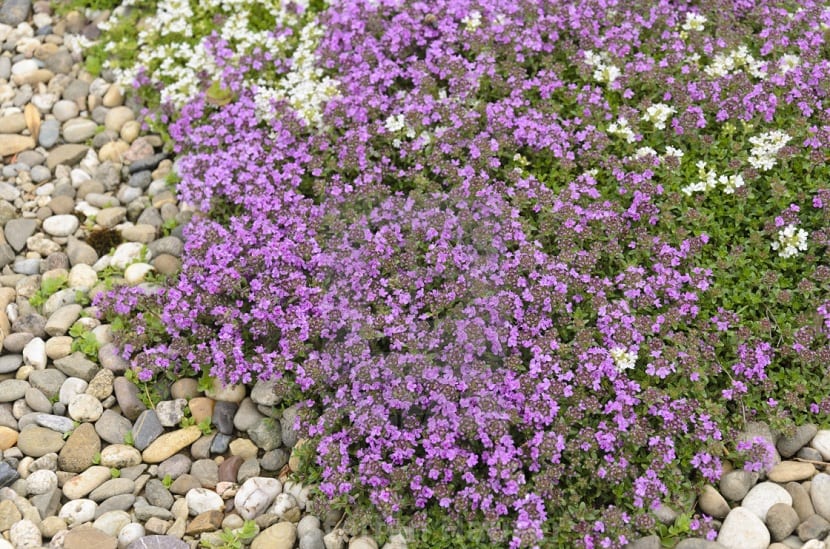
Today we are going to talk about a plant that serves to cover the uncovered grounds of your garden. Its about Thymus serpyllum. It is also known by the common name of serpol or sanjuanero thyme. They belong to the Lamiaceae family and come from Europe. Plants of the genus Thymus come from the temperate regions of Europe, North Africa and Asia. In this genus of plants there are more than 350 species of aromatic herbaceous plants.
In this article we are going to tell you everything you need to know about the Thymus serpyllum, as well as its characteristics, its main uses and the care it needs.
Key features

It is a prostrate plant and extended that are usually between 10 and 25 centimeters high. It is considered a perfect bush to cover clearer areas of your garden. It has small dark green leaves and purple-pink flowers. Despite its appearance, it has a high ornamental value and medicinal properties.
Its flowering takes place in the first half of summer when temperatures reach their highest point. The Thymus serpyllum specifically, it is a plant that comes from Europe and it is quite common to find it in Spain. Its use is quite widespread both in the ornamental field and in landscape restoration. It is more common to know it by the name of San Juan thyme.
When you touch this aromatic plant, it gives off a slight aroma. The leaves are quite small of the lanceolate type, growing in an opposite way and with a dark green color. The flowers are also small in size of the bilabiated type and are grouped in corymbs.
Uses of Thymus serpyllum

As we have mentioned before, this is an excellent plant to cover the driest soils and those areas that do not have vegetal cover. Thus, we can use it in the world of gardening in areas with little water or for places that need restoration.
In the wild, the Thymus serpyllum it shares habitats with other hillside species that are oriented to the sun. For example, one of those species is acinus alpinum. To decorate the gardens, this plant comes in handy in combination with rosemary or santolina. One of the most widespread uses is to control erosion in arid places. This is because it has the ability to fix the ground it is on very well. In lands that suffer from desertification, it is an interesting plant to restore the ecosystem, since we have a plant that is able to resist drought well and also help prevent erosion. As we will see later, it is not a plant that needs too much care.
Similarly, in gardening it is quite appreciated as a covering plant to cover small surfaces. They have the great advantage that it requires much less water consumption than a lawn and also supports moderate trampling. It is one of the plants that is most used in xero-gardening. For those who do not know, xerogardening is a planning of a garden in which exotic plants abound that need little water. In this way, a garden is built with low maintenance but with great ornamental value.
Caring for the Thymus serpyllum

Normally, in the natural habitat, the sanjuanero thyme grows on soils that are very poor in nutrients and quite arid. It can withstand drought quite well so it would adapt perfectly to our type of climate.
An important aspect to keep in mind is that you need well-drained soils. That is, when it rains or we water the water does not accumulate. If the irrigation water accumulates, it is likely that the tall plant will die.
As for the exposure, it must always be in full sun. If we place it in a shady area, its flowering will be much poorer. The planting frame will depend a lot on how long we want the plant to be covering the ground. If we are not in a hurry, it is best to plant about four specimens for each square meter of land. If, on the other hand, we need the garden floor to be covered as soon as possible, we can place up to six plants for each square meter of land.
Since it is a plant that withstands drought quite well, it hardly needs watering. Just increase the frequency of watering a little more in summer. In winter it is enough with the water of the precipitations. If a dry season has come, we can water with the indicator that the soil is completely drying up.
If we want to multiply the Thymus serpyllum We can do it by means of seeds or by cuttings during the spring time. This is done because the high temperatures help the plant to adapt better and to be able to develop in good conditions.
Medicinal properties

The active principles in the flowers and leaves of serpol make this plant have medicinal properties. Contains an essential oil rich in cimol and pinene. It also contains tannins, resin and other more bitter substances.
Among the qualities that this plant possesses we have a remedy to mitigate coughs. It also has the ability to be antiseptic and antipyretic. It is used to aid digestion and removes worms from the intestines. In addition, in general, it helps to tone the body by acting on the nerve centers and promoting blood circulation.
Another of the medicinal properties of sanjuanero thyme is that it is an effective natural febrifuge that helps clear the respiratory tract. It prevents the spread of various fungi that are present in swimming pools and public showers. These benefits are used in ointments that are intended to calm tension headaches. In this way, it is possible to take advantage of all the analgesic properties both to treat cases of rheumatism, such as gout, lumbago or tired feet.
Serpol extract can be used in syrups against coughs, common colds and gastrointestinal disorders. For its collection, it must be done when the buds open throughout the summer. They are left to dry in the shade once collected and are kept from light and humidity.
I hope that with this information you can know more about the Thymus serpyllum.